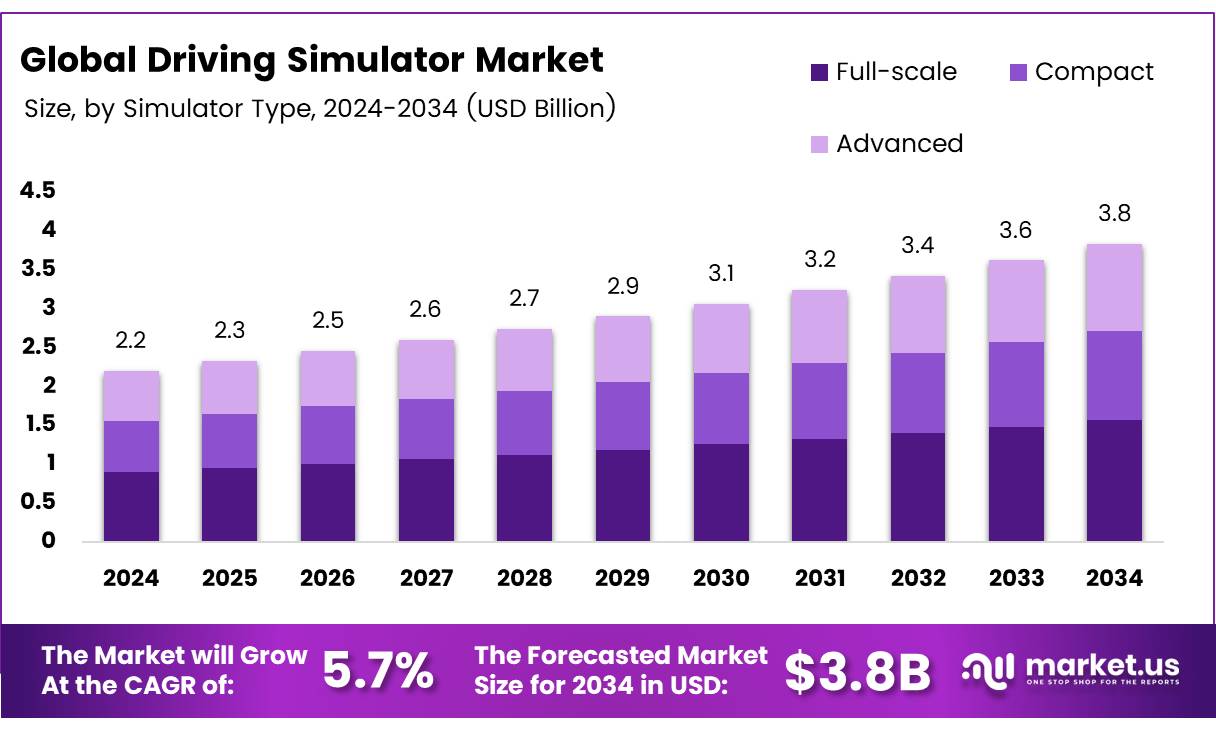Table of Contents
Market Overview
The Global Driving Simulator Market size is expected to be worth around USD 3.8 Billion by 2034, from USD 2.2 Billion in 2024, growing at a CAGR of 5.7% during the forecast period.
The Driving Simulator Market is growing fast due to safety needs. Simulation helps reduce road accidents and improve driver skills. More training institutes now prefer simulators over real vehicles. Demand rises as companies aim for risk-free driver training. Governments push for safer transport with strict rules. Simulator use is now part of licensing tests in many countries. These trends support steady market growth worldwide.

Opportunities are high in aviation, marine, and defense sectors. Simulators cut training costs and prevent equipment damage. In the maritime sector, over 70% of STCW-approved centers use simulation tools. This shows strong trust in simulator-based learning. VR and AI add value to simulator systems today. These tech upgrades attract more buyers in logistics and education.
Public and private investments are boosting this market. Governments invest to improve public safety and skill levels. Policies now support simulator use in driver training programs. Standard rules across regions drive more adoption. Key players focus on real-time data and custom training modules. These efforts ensure long-term growth and innovation.
In short, simulation is the future of driver training. It offers safety, cost savings, and better skills. The market will grow stronger with tech and policy support.
Key Takeaways
- The global Driving Simulator Market is projected to reach USD 3.8 billion by 2034, growing at a CAGR of 5.7% from 2025 to 2034.
- Full-scale simulators held a 40.1% market share in 2024, driven by precision needs in professional training and research.
- The Research & Testing segment dominated in 2024 due to increased demand for reliable automotive safety and design solutions.
- The automotive sector led the By End Use category in 2024, powered by rising ADAS and autonomous vehicle development needs.
- Asia Pacific emerged as the largest market, contributing 34.2% or USD 0.7 billion in 2024, fueled by rapid industrialization and investment in transportation.
Market Drivers
- Road Safety Focus: Simulators help reduce accidents by enabling safe, controlled driver training environments.
- Autonomous & EV Growth: They support testing of electric and self-driving vehicles in simulated conditions.
- Cost-Effective Training: Simulators lower training expenses by eliminating fuel use and vehicle wear.
- Scalability & Customization: They can be tailored for various industries like logistics, public transport, and defense.
Market Challenges
- High Initial Investment: Full-scale simulators require heavy capital, limiting adoption by smaller institutions.
- Technical Limitations: Simulators can’t fully mimic real-world emotions like stress or fatigue.
- Hardware Maintenance: Frequent upkeep and upgrades are needed due to evolving simulator technologies.
Segmentation Analysis
Simulator Type:
Full-scale simulators led with 40.1% in 2024. Compact and advanced types are growing due to cost-efficiency and tech features like VR.
Application:
Research & Testing dominated, driven by safety and design needs. Training and gaming are growing but smaller.
End Use:
Automotive led the market, followed by marine and aviation, due to rising demand in R&D and training.
Regional Insights
Asia Pacific leads the driving simulator market in 2024 with 34.2% share (USD 0.7 billion), driven by rapid growth in automotive sectors and strong demand for training and R&D in countries like China, India, and Japan.
North America follows, supported by advanced tech, top automakers, and strong focus on autonomous vehicles and ADAS.
Europe holds a solid share, with high simulator use in Germany, France, and the UK for R&D and strict safety regulations.
MEA and Latin America are smaller markets but growing steadily due to rising road safety efforts and adoption of simulation for training.
Recent Developments
- In June 2025, Today successfully raised $5 million to develop a Web3-based game featuring advanced AI-powered NPCs, aiming to revolutionize player interaction and game immersion. The funding will accelerate product development, hiring, and blockchain integration to support their next-gen gaming vision.
- In September 2024, Treble Technologies secured €11 million in a Series A round to scale its next-gen sound simulation and synthetic audio data technology. The investment will be used to expand R&D, grow the engineering team, and enter new markets with its immersive audio solutions.
- In October 2024, Outlier Games Limited announced the completion of a €583,000 ($640,000) pre-seed round to support the early-stage development of its upcoming video game projects. The Irish studio plans to use the funding for prototyping, talent acquisition, and laying the groundwork for future growth.
Conclusion
The global Driving Simulator Market is on a strong growth path, expected to hit USD 3.8 billion by 2034. This rise is fueled by increasing safety needs, tech integration like VR and AI, and government support for simulation-based training. High adoption in sectors such as automotive, defense, marine, and aviation shows growing trust in cost-effective, risk-free training methods. While challenges like high costs and tech limitations exist, investments and standardized regulations continue to push the market forward. With rising demand in Asia Pacific and tech-driven advancements, simulation is set to become the standard for driver education and research worldwide.
Discuss your needs with our analyst
Please share your requirements with more details so our analyst can check if they can solve your problem(s)



